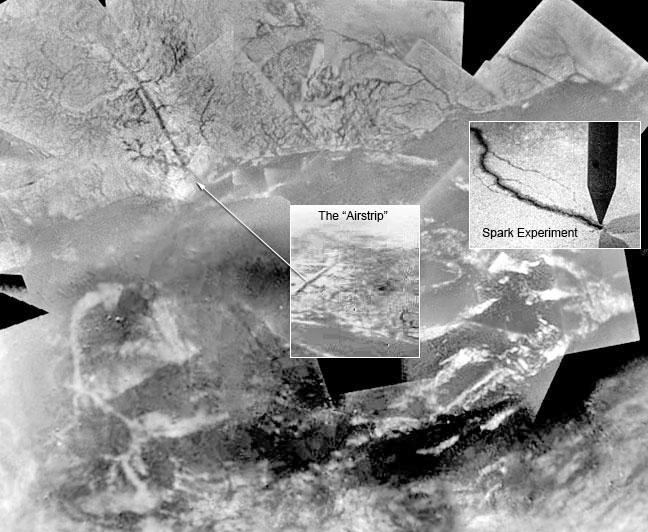|

from
Thuntherbolts Website
Jan 18, 2005

Credit: ESA/NASA/Univ.
of Arizona, Jakub Friedl combined the Huygens mosaics
A major surprise from the Huygens images of Titan was the
appearance of drainage channels. The dark channels
in the mosaic image above bring to mind similar patterns in high
altitude images of river systems on Earth. But a closer inspection
uncovers details that are more characteristic of electrical
flows than of liquid flows. And not unexpectedly, these
channels are indistinguishable from channels on Mars,
Venus, the Moon and most other solid
bodies in the solar system. All of these channels are the result of
cosmic electrical scarring.
We can be certain of this explanation for the channels on Titan
based on particular characteristics evident in the images from
Huygens. The feature nicknamed the airstrip shows the effects seen
in the spark experiment inset: a long, constant-width central
channel within a broader cleared channel. The tributary channels of
the airstrip are stubby and have no feeder channels. They begin
abruptly and tend to join the main channel at near right angles. And
as they join it, the main channel does not broaden: Common liquids
are incompressible, and an increased volume requires a larger
channel. But electrical "flows" can increase their current density
in a constant channel size.
In the upper right quadrant we see channels that appear to flow into
a dark "lake" or a "sea." But again a closer inspection reveals that
some of the channels start and end at the shoreline, which is
clearly impossible for any liquid. Some tributaries also leave and
rejoin the main channel in the same manner we see in the spark
experiment. And once again we see stubby tributaries that join other
channels preferentially at near right angles. The "lake" also shows
evidence of dark filamentary scarring, and the "shoreline" shows a
larger-scale arcuate scalloping typical of electrical etching.
The light filamentary patterns in the lower left quadrant also
suggest an electrical origin.
The dark area may be where material has been electrically removed or
etched and the surface burnt or melted by an arc in the same
manner as we see today on Io. The shoreline grew brighter as
Huygens descended. Marty Tomasko, the Principal Investigator for the
Descent Imager Spectral Radiometer, suggested that it might be due
to a methane fog hugging the shore. The electrical model suggests
an alternative the brightening may be due to steep cliffs along
the shoreline, where electrical etching has exposed lighter
material.
The "drainage channel" interpretation reveals the bias of geocentric
and anthropocentric presumptions peculiar to our origins on the
relatively (or at least recently) plasma-free surface of the Earth.
In the rest of the universe electrical plasma effects dominate. Now
that our sensors have entered that other domain, we need at least to
consider electrical interpretations of the surprising phenomena we
discover. In doing so we must be prepared to discard the old fables
we have been taught about the history of Titan, Saturn and the
solar
system.
|